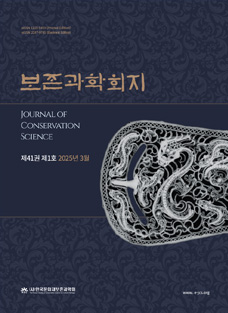Journal of Conservation Science Vol.23 No.0 pp.25-37
보성 거석리 및 해남 분토리 유적 출토 녹니석제 구슬의 재질특성과 원산지 해석
Material Characteristics and Provenance Interpretation for Chloritic Beads from the Boseong Geoseokri and Haenam Buntori Sites, Korea
Jiyoung Kim,Chan Hee Lee,Jin Young Kim
Abstract
This study focuses on identification of mineralogical and geochemical characteristics and interpretation of raw material sources for prehistoric chlorite beads excavated from Geoseokri site in Boseong and Buntori site in Haenam, Korea. These prehistoric beads consist of three grayish blue ring-shaped beads, one dark green tubular bead and one greenish black tubular bead that show acicular-columnar and fibrous microtexture. The beads are composed of SiO2, Al2O3, MgO and FeO as majors and a trace amount of K2O, CaO and Na2O. Mineral species is mostly chlorite with a small amount of quartz and feldspar. Quantitative analysis indicates that the grayish blue ring-shaped beads and the dark green tubular bead belong to clinochlore and the greenish black tubular bead does to the boundary between clinochlore and sheridantie. Chlorite is a hydrous phyllosilicate mineral and it shows various microtexture of acicular, sheeted, earthy, granular and fibrous shapes. As its hardness is 2, chlorite is easily engraved due to its softness. It has aesthetic worthy as it shows green, black and greenish gray colors and pearly to greasy luster as well. These factors would lead to the extensive use of chloritic beads as ornaments from prehistoric times. Though the mineral sources of the chlorite beads can be found in central western region of Chungnam and Iwon of Hamnam, those areas are too distant from the two relic sites. Instead, chlorite ores commonly occur as altered products in wall rock alteration zone of every hydrothermal deposit. Therefore, it is probable that raw materials of chlorite were supplied from neighboring hydrothermal environment rather than far deposits. The result needs further study to verify raw material provenance interpretation, supply, manufacture and distribution on the basis of archaeological points of view.

 E-Submission
E-Submission 
 E-Submission
E-Submission 
![]() Journal Search Engine
Journal Search Engine




 KSC
KSC